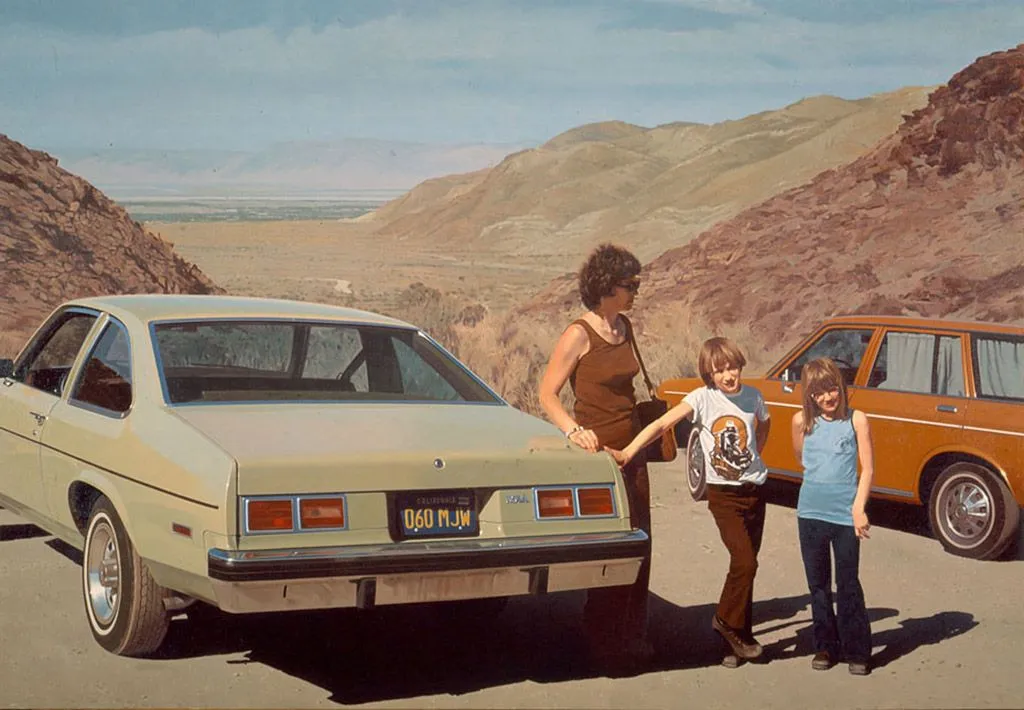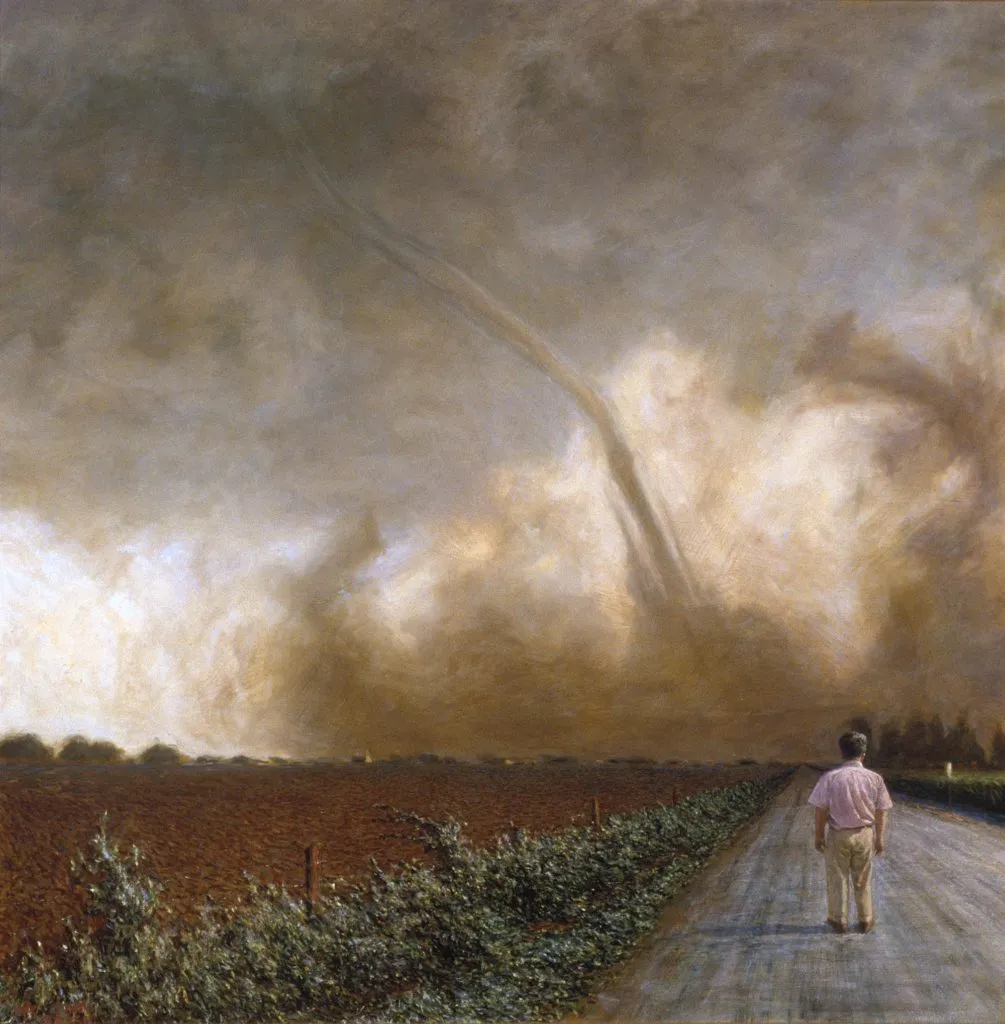Oreskes and Conway state in their text ‘The collapse of Western Civilization: A view from the future’ that artists might be among the first to understand the magnitude of climate change (2013:43).
I will take a closer look at three specific paintings to investigate how looking at painting might tell us something about the human relationships with nature at different key points in the Anthropocene history. I will analyse this narrative and question how art can play a role not only in portraying the Anthropocene, but in conveying thoughts and feelings which might be crucial to understand if we are to create a sustainable future.
The paintings chosen were created in three different key times in the history of the Anthropocene: the Industrial Revolution, the Great Acceleration, and the increasing discussions about global warming in the 1990s (Chakrabarty 2009:199). I believe that these paintings can encapsulate how human culture creates our understanding of nature, but also the important role which nature plays in our culture.
The Paintings :
The wanderer above a sea of mist (also known as ‘Wanderer above the sea of fog’, ‘The wanderer above the mists’) by Caspar David Friedrich, made in 1818 (Wolf 2015:94).
Agua Caliente Nova by Robert Bechtle, made in 1975.
Indecision by John Brosio, made in 1994.
The wanderer above a sea of mist

In all of Friedrich’s work the concept of nature comes with a stream of psychological undertones; such as the perception of God within nature and the encounter of the human inner psyche (Stumpel 2008:43-46). As such it can lend itself as a mirror to understand humanity’s view of both itself and nature in the latter part of the Industrial Revolution.
At the time when ‘The wanderer above a sea of mist’ was painted humanity’s relationship with nature had changed due to the Industrial Revolution. Through the discovery of fossil fuel humanity found means of using nature to its advantage in a capacity not known before (Steffen et al. 2011:848).
Just a few decades after the creation of this painting John Stuart Mill declared in his book Nature from 1874 that nature was to be conquered, not obeyed (Björk 2016:96). At the same time as nature was to be conquered it was also revered, and those who could afford to, took holidays seeking out the most spectacular vistas which could be found and declared them a piece of Heaven (Cronon 1996:09).
I believe that ‘The wanderer above a sea of mist’ encompasses those early days of awe and fear of nature alongside a longing to conquer it once and for all. We see a man standing on a cliff, above the misty mountains spread before him. Nature is shown as a widespread unknown stretching out into infinity and half covered by mist; suggesting it is not yet all ours. But the placement and the stature of the man imply that nature is something which is soon to be under his command.
I believe this painting shows both the yearning for the untouched landscape and the quest to dominate nature once and for all. It is in stark contrast to the next painting, where nature seems to have become just another commodity among others.
Agua Caliente Nova

After the end of WWII initiatives were brought into place to encourage renewed economic growth. This, combined with new technology, raised the standard of living for many people while at the same time ignoring vast environmental damage and colonial implications (Steffen et al. 2011:850-852). ‘Agua Caliente Nova’ depicts a moment in these times of the Great Acceleration and gives us an updated view of nature and the modern life in Western society. It depicts an ordinary world, in which we are bound to the car and to a growing suburbia, but it mixes this with an awkward feeling of alienation (Freeman 2000:128); it is almost too serene.
In a time where the Blue Marble made way for a new Nature to objectify and master, indigenous and poor white people who had historically been displaced due to the construction of national parks now paid the price for atomic testing; toxic wastelands spread over Utah, Nevada and New Mexico (Lekan 2014:181-182). The white middle class American dream depicted in ‘Agua Caliente Nova’ is unsettling because it narrates the eradication of these events in the minds and memories of American people. Land which has been fought over has become not much more than a pretty background for a family day out.
The portrayal of the awe inspiring landscape has changed dramatically from Friedrich’s work. It is no longer the lone explorer who dares to go into the barren wilderness nor is it a picture of the sublime Godly landscape (Cronon 1996:08, 1996:10), but a family scene of a day out with the nature as a mere backdrop. It implies that you no longer need to be a great explorer to see the wilderness, but that the wild has been brought to you in moderated forms of tourism enjoyed by those who can afford it (Cronon 1996:21). Even more telling is that the main protagonist is neither human nor nature; but a car taking up a large part of the picture. This image ties in with this period’s steady rise in motor vehicle usage, international travel, electronic communication and a growing urban population. It also visually tells the story of how natural ecosystems during the Great Acceleration are increasingly and rapidly changed into human-dominated landscapes (Steffen et al. 2011:849-850).
The dichotomy of being lost in nature while also being its master, as described in Friedrich’s work, seems lost here. In this painting humans seem to have advanced in the mastery of nature to the point where ‘wilderness’ comes neatly packaged and to which you can take the car.
Indecision

After incidents such as the acid rain in the 1980s, and the growing awareness of CO2 emissions (Steffen et al. 2011:852) global warming slowly started to be discussed in the 1990s. But it wasn’t until early the 2000s that it truly became a public concern (Chakrabarty 2009:199).
Many of Brosio’s paintings encompass these times’ imaginations of what nature is capable of, and the smallness of man. Looming natural disasters are combined with unstirred humans in the foreground; people who carry on with their lives as if nothing is happening (Dawson, 2008). In ‘Indecision’ the person seems helplessly paralyzed without knowing what to do about the oncoming disaster. The nature around him has been changed into a human dominated landscape, but from afar an uncontrolled force of nature seems to be on course to destroy what humanity has built for its existence.
Brosio himself describes his work like this:
It is… my take on pretence or how much we have to fool ourselves to maintain a sense of civilization against the forces that will eventually claim us all. (Dawson, 2008)
From the almost surreal stillness of Bechtle’s paintings where nature is controlled as a well maintained garden or as a beautiful but unfrightening vista, Brosio’s work captures the growing alarm of later times. He keeps portraying people, houses, worked land and an overall nostalgic scene but instead of showing it as a forever existing scene, Brosio implies that our lifestyle comes with impending disaster, and that we don’t want to look.
In Brosio’s work nature returns as a force that demands to be the protagonist; not in the romantic way in which Friedrich portrayed nature in the nineteenth century, but as something out of a dystopian science fiction fantasy. Compared to Friedrich’s painting, humans have now lost their secure stance and are left paralyzed, not knowing how to manage the geological force which we have become (Chakrabarty 2009:206).
Conclusion
For centuries painting has been a way for humans to express ourselves and to investigate our relationship to nature and the world around us. Consciously and unconsciously painters have mirrored the time in which they have lived. Therefore I believe that we can find some answers within the arts to the more existential questions of the Anthropocene and human behaviour.
Art allows us to move the idea of the Anthropocene beyond natural science and it enables us to engage with the moral and ethical context of global change (Robin et al. 2014:208). It allows us to reach beyond an intellectual interpretation and enables an emotional understanding of what is going on around us.
In the same way that we need culture to grasp the concept of nature, we need culture to understand our own actions and responses in a rapidly changing world. Art can supply a well needed tool to reverberate contemporary issues on a deeper level, enabling us to fully come to terms with our situation, assess it, and move forward towards a hopefully more sustainable future.
References:
Björk, Nina (2016), Drömmen om det röda – Rosa Luxemburg, socialism, språk och kärlek, Falun: Wahlström & Widstrand
Boele, Vincent and Foppema, Femke (red.) (2008), Caspar David Friedrich & the German Romantic Landscape, Hampshire: Lund Humphries (anthology)
Chakrabarty, D. (2009). The Climate of History: Four Theses. Critical Inquiry, 35(2), 197–222. https://doi.org/10.1086/596640
Cronon, W. (1996). The Trouble with Wilderness: Or, Getting Back to the Wrong Nature. Environmental History, 1(1), 7–28. https://doi.org/10.2307/3985059
Dawson, Jessica (2008). In ‘Tornadoes,’ the Calm That Tempers the Storm; John Brosio’s Collection of Midwestern Scenes Are Drenched in Nostalgia but Miss the Thunder. The Washington Post; Washington D.C.7 November. https://search.proquest.com/docview/410311292?accountid=16574 (Retrieved 2017-01-13)
Freeman, Marina (2000). A California Realist. Southwest Art; Broomfield, 29 (12), 124-128, https://search.proquest.com/docview/216316693?accountid=16574 (Retrieved 2017-01-13)
Lekan, T. (2014). Fractal Eaarth: Visualizing the Global Environment in the Anthropocene. Environmental Humanities, (5), 171–201. Retrieved from http://environmentalhumanities.org/arch/vol5/5.10.pdf
Oreskes, N., & Conway, E. M. (2013). The Collapse of Western Civilization: A View from the Future. Daedalus, 142(1), 40–58. https://doi.org/10.1162/DAED_a_00184
Robin, L., Avango, D., Keogh, L., Mollers, N., Scherer, B., & Trischler, H. (2014). Three galleries of the Anthropocene. The Anthropocene Review, 1(3), 207–224. https://doi.org/10.1177/2053019614550533
Steffen, W., Grinevald, J., Crutzen, P., & McNeill, J. (2011). The Anthropocene: conceptual and historical perspectives. Philosophical Transactions of the Royal Society A: Mathematical, Physical and Engineering Sciences, 369(1938), 842–867. https://doi.org/10.1098/rsta.2010.0327
Wolf, Norbert (2015), Friedrich, 2 uppl. Köln: Taschen